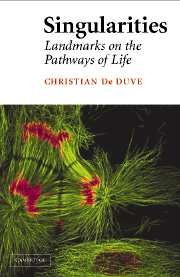Book contents
- Frontmatter
- Contents
- Foreword
- On Christian de Duve: An Editor's Appreciation
- General Introduction
- 1 Building Blocks
- 2 Homochirality
- 3 Protometabolism
- 4 ATP
- 5 Electrons and Protons
- 6 Thioesters
- 7 RNA
- 8 Proteins
- 9 DNA
- 10 Membranes
- 11 Protonmotive Force
- 12 Protometabolism Revisited
- 13 The LUCA
- 14 The First Fork
- 15 Eukaryotes
- 16 Oxygen
- 17 Endosymbionts
- 18 Multicellulars
- 19 Homo
- 20 Evolution
- Final Comments
- Bibliography
- Index
17 - Endosymbionts
Published online by Cambridge University Press: 18 January 2010
- Frontmatter
- Contents
- Foreword
- On Christian de Duve: An Editor's Appreciation
- General Introduction
- 1 Building Blocks
- 2 Homochirality
- 3 Protometabolism
- 4 ATP
- 5 Electrons and Protons
- 6 Thioesters
- 7 RNA
- 8 Proteins
- 9 DNA
- 10 Membranes
- 11 Protonmotive Force
- 12 Protometabolism Revisited
- 13 The LUCA
- 14 The First Fork
- 15 Eukaryotes
- 16 Oxygen
- 17 Endosymbionts
- 18 Multicellulars
- 19 Homo
- 20 Evolution
- Final Comments
- Bibliography
- Index
Summary
As mentioned in Chapter 15, there is considerable disagreement concerning the manner in which the initial relationship between prospective host cells and endosymbionts may have been launched. What followed, however, is fairly well understood, at least in its main lines, from features that are common to the two historically established instances of endosymbiosis. Whether in the case of mitochondria or that of chloroplasts, essentially two kinds of events were involved in the adoption of the organelles.
In both cases, the endosymbionts have lost a major part of their genes, and a certain number of these have been transferred to the host-cell nucleus and integrated within its genome in a manner that allowed replication and transcription of the genes by the local mechanisms. Interestingly, it may happen that such genes or remnants of them remain in the nucleus after the organelles themselves have been lost or become degenerate. This kind of evidence first revealed that the ancestors of certain amitochondriate protists may once have contained mitochondria, a finding that, as we have seen, was brandished against the primitive-phagocyte hypothesis.
The second phenomenon consists in the translocation into the endosymbiont of the protein products of certain endosymbiont genes displaced to the host-cell nucleus. Such proteins are synthesized, like the host-cell proteins, by cytosolic ribosomes instructed by RNA messages transcribed in the nucleus. If the proteins play an essential role in the endosymbiont, their translocation must be operative before the relevant gene is definitively lost by the endosymbiont and transferred to the nucleus.
- Type
- Chapter
- Information
- SingularitiesLandmarks on the Pathways of Life, pp. 203 - 213Publisher: Cambridge University PressPrint publication year: 2005

